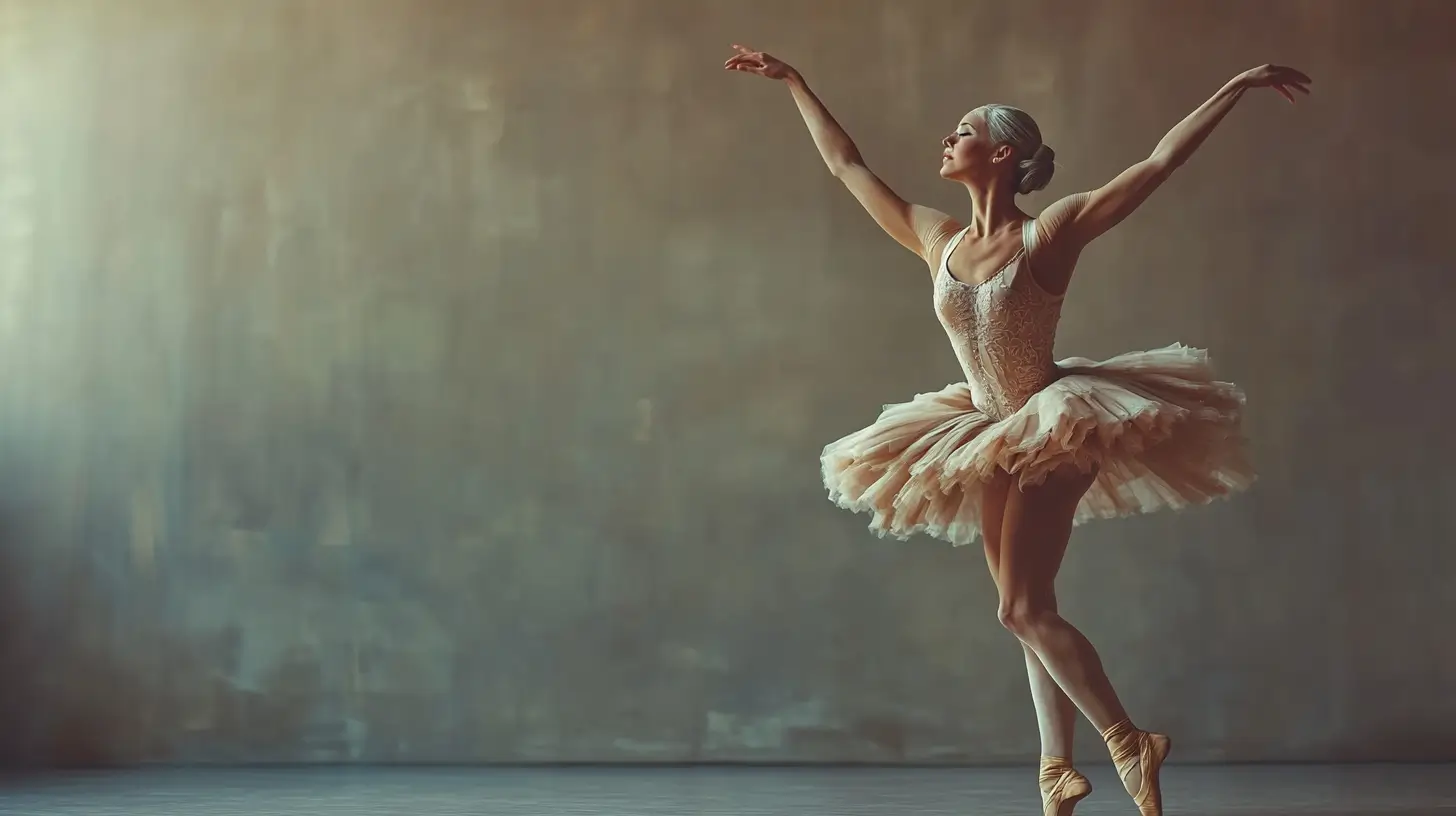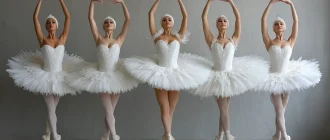When do ballet dancers retire? Active dancers expect to stop dancing and performing around 35 due to physical strain. However, this age can vary and can be influenced by injuries and career aspirations. This article explores why dancers retire and transition, and what life is like after ballet.
Graceful Insights
- The average retirement age for ballet dancers is around 35. Physical demands, injuries, personal aspirations, and emotional factors influence this. Pointe shoes, essential for female dancers, also contribute to the physical needs and potential injuries that influence retirement age.
- Physical injuries, emotional strain, and financial constraints are significant factors in a dancer’s retirement decision.
- Ballet companies are crucial in supporting retired dancers through career transition programs, continuing education, and mentorship initiatives.
Art de Podcast
| Aspect | Description |
|---|---|
| Average Retirement Age | – Typical Age Range: 35-40 years old – Variation: Depends on individual health, career opportunities, and personal decisions |
| Physical Demands & Injuries | – High Physical Strain: Intense training and performances lead to wear and tear – Common Injuries: Stress fractures, tendonitis, joint issues |
| Peak Performance Age | – Prime Years: Early 20s to mid-30s – Physical Decline: Natural aging affects strength, flexibility, and recovery time |
| Company Policies | – Mandatory Retirement: Some companies enforce age limits – Contract Limitations: Older dancers may face fewer contract renewals |
| Gender Differences | – Female Dancers: Often retire earlier due to physical demands and career progression – Male Dancers: May have longer careers due to different roles |
| Transition Opportunities | – Within Dance: Teaching, choreography, coaching, artistic direction – Outside Dance: Pursuing new careers requiring additional education or training |
| Financial Planning | – Short Earning Span: Emphasis on early savings and investment – Post-Retirement Income: Importance of planning for financial stability after retiring |
| Psychological Factors | – Identity Shift: Coping with the end of a performing career – Support Systems: Access to counseling and career transition programs |
| Health & Wellness | – Long-Term Health: Managing chronic injuries and health issues – Wellness Programs: Participation in programs that promote longevity and health |
| Education & Skills | – Continued Learning: Acquiring new skills for second careers – Higher Education: Some pursue degrees during or after dance careers |
Note: The retirement age and experiences can vary widely among ballet dancers based on personal choices, opportunities, and the demands of their company roles.
The Brief Career of a Professional Ballet Dancer
A professional ballet dancer’s career is typically short-lived. Most retire in their mid-to-late 30s. This brief career span is due to the physically demanding nature of the job, which requires dancers to maintain a high level of physical fitness and technical skills. The average retirement age for professional ballerinas is around 30, with some retiring as early as their late 20s.
The intense training and performance schedules take a toll on the body, making it challenging for most dancers to sustain their careers for extended periods. Despite the brevity of their performing careers, dancers often achieve remarkable feats and leave lasting impressions on audiences worldwide. The dedication and passion required to excel in ballet are immense, and the short career span underscores the extraordinary commitment of these artists.
Typical Retirement Age for Ballet Dancers

For most ballet dancers, their performing career ends around age 35. This may surprise many, given the intense physical demands and peak physical condition required to excel in ballet. However, 35 is considered the average retirement age for mature dancers, marking a critical transition point in a dancer’s life.
Despite this average, many active dancers expect to continue performing well into their 40s. Advancements in training techniques, better injury management, and a deeper understanding of the human body drive this optimism.
However, the reality remains that the physical demands of ballet often catch up with older dancers, necessitating an earlier retirement than they might have hoped. This expectation gap creates a psychological struggle during the transition to post-performance life.
The retirement age can vary significantly among dancers due to individual physical conditions, the type of roles they perform, and personal aspirations. These elements collectively influence when dancers retire from the stage. While some may retire earlier due to injuries or other factors, others may extend their careers through careful management and adaptation.
Factors Influencing Retirement
Many factors influence the decision to retire from ballet, with physical injuries being one of the most significant. Pointe shoes, essential for female dancers, can also contribute to injuries such as stress fractures and tendonitis.
Most professional dancers, between 55% and 90%, suffer injuries, significantly influencing their decision to retire. Injuries such as hip impingement, Achilles tendonitis, and stress fractures are common and can severely limit a dancer’s ability to perform.
Beyond physical injuries, emotional experiences also play a crucial role in a dancer’s retirement. Negative instructor feedback, the pressure to perform despite the pain, and the emotional toll of balancing academics with ballet can lead to exhaustion and loss of interest. These emotional burdens can be as impactful as physical injuries, pushing dancers to retire.
Financial constraints are another critical factor. Ballet training and maintaining a dance career can be expensive, and not all dancers have the financial resources to continue indefinitely. The economic burden of further education or transitioning to a new job can also influence retirement timing.
Ultimately, the decision to retire is often a combination of these factors. Physical injuries, emotional tolls, and financial constraints collectively shape the retirement pathway for many dancers. Each dancer’s journey is unique, and their reasons for retiring are deeply personal.
Factors Contributing to Early Retirement
Several factors contribute to the early retirement of professional ballet dancers. One major factor is the physical toll of dancing, which can lead to injuries and chronic pain. The repetitive movements and high-impact routines often lead to conditions like stress fractures, tendonitis, and joint issues, making it difficult for dancers to continue performing at their best.
Additionally, the constant pressure to maintain a certain physical appearance and the stress of performing can take a mental and emotional toll on dancers. The rigorous demands of the profession, coupled with the need to balance personal and professional lives, can lead to burnout and emotional exhaustion.
Furthermore, the competitive nature of the dance industry means that younger, more energetic performers often replace dancers. This relentless competition can create a sense of urgency to retire early as dancers face the reality of being outpaced by the next generation. These combined factors make early retirement a common outcome for many in ballet.
Life After Dance: Career Transitions

Many retired dancers find new ways to share their passion and expertise when the curtain falls on a ballet career. A common path is transitioning to teaching roles, where they can pass on their knowledge to teach the next generation of dancers. This transition allows them to stay connected to the art form they love while nurturing young talent.
Another popular career transition is choreography. Retired dancers often become choreographers, creating and directing new performances that bring fresh perspectives to the stage. In addition, some former dancers move into dance administration or other company management roles, utilizing their industry experience to support and promote the art.
Recognizing their skills outside the dance world can be challenging for many dancers. However, some find fulfillment in a career as a professional dancer or fitness and wellness coach, leveraging their understanding of physical health and discipline. Others advocate for the arts, promoting dance and arts education in broader communities.
Ballet companies support these transitions by engaging retired dancers in educational and community outreach programs. These initiatives provide employment opportunities for active dancers and allow retired dancers to share their experiences, inspiring others. Despite the challenges, with the right support and opportunities, many dancers successfully transition to rewarding new careers.
The Value of Experience: How Retiring Dancers Contribute to the Dance World
While professional ballet dancers may retire from performing, their experience and knowledge are still highly valued in the dance world. Many retired dancers become teachers, choreographers, or directors, sharing their expertise with the next generation. This transition allows them to continue contributing to the art form they love, fostering new talent and ensuring the continuity of ballet traditions.
Others may work as coaches or mentors, helping younger dancers to develop their skills and navigate the challenges of a dance career. Their firsthand experience provides invaluable insights and guidance, making them essential figures in the dance community. Retired dancers also play a crucial role in dance administration, where their understanding of the industry helps shape policies and programs that support active dancers.
The legacy of retired dancers extends beyond the studio and stage. They often engage in arts advocacy and community outreach. By promoting dance education and accessibility, they help cultivate a broader appreciation for ballet and inspire future generations to pursue their passion for dance.
Physical Demands and Injury Prevention
The physical demands of ballet are immense, requiring strength, flexibility, and stamina. Pointe shoes, specifically designed for female dancers to perform on their toes, can lead to overuse injuries if not managed properly.
These demands increase the risk of injuries, particularly overuse injuries affecting the ankles, legs, feet, and lower back. Common injuries include hip impingement, Achilles tendonitis, and stress fractures, often resulting from excessive training without adequate recovery.
To mitigate these risks, dancers are advised to incorporate cross-training activities such as Pilates and cardio exercises into their routines. These activities help enhance overall strength and stamina while reducing the likelihood of injury. Adequate rest is also crucial, with recommendations suggesting at least two consecutive days off after intensive training to allow for recovery.
Injury management practices are essential for dancers, as ignoring pain can lead to more severe issues and premature retirement. Prompt treatment of injuries using the RICE method (rest, ice, compression, elevation) is crucial for initial management and long-term health. Dancers can extend their careers and maintain physical health by focusing on injury prevention and proper management.
Emotional and Psychological Aspects
A dancer’s career is deeply intertwined with their emotional and psychological aspects. Many active dancers expect to have long performing careers, but the reality of physical limitations often leads to earlier retirement. Injuries can cause significant psychological distress, impacting performance capabilities and contributing to retirement. The cultural expectation to perform despite pain usually creates a fear of being perceived as weak, affecting dancers’ willingness to report injuries.
Retirement from ballet can lead to identity challenges, as many dancers have dedicated their entire lives to the art form. This transition often involves a form of mourning, as retirement symbolizes the end of a profound aspect of their identity in early childhood. Research indicates that a significant portion of retired athletes experience mental health issues, with only half feeling in control of their lives two years post-retirement.
However, some retired ballet dancers experience a significant shift in their passion and pursue new interests after leaving dance. This shift can lead to new opportunities and fulfillment, highlighting the resilience and adaptability of dancers as they navigate life after stopping their professional dancing careers and performing.
Case Studies of Retired Dancers

Real-life case studies of retired dancers provide valuable insights into their career transitions and the pathways most dancers choose afterward. These stories highlight the diverse opportunities available and the resilience of dancers in adapting to new careers.
For instance, some retired dancers have successfully transitioned to roles in teaching and choreography, finding new ways to express their creativity and passion for dance. Others have moved into dance administration, fitness coaching, music, or arts advocacy, utilizing their unique skills and experiences to make a positive impact in various fields.
The successful transitions of these female dancers significantly impact their identities, cultivating a sense of fulfillment and purpose in their new careers. Ballet companies often celebrate these achievements, helping to validate their past experiences and transitions. These case studies inspire and prove that life after dance can be rewarding and meaningful.
Breaking the Mold: Dancers Who Defy Traditional Retirement Ages
While most professional ballet dancers retire in their 30s, some defy traditional retirement ages and continue to perform well into their 40s, 50s, and even 60s. These dancers are often exceptions to the rule, having maintained a high level of physical fitness and technical skill throughout their careers. They may also have found ways to adapt to the changing demands of the dance industry, such as transitioning to character or contemporary roles.
These mature dancers bring a wealth of experience and depth to their performances, often portraying roles that require a nuanced understanding of character and emotion. Their continued presence on stage challenges the conventional expectations of a dancer’s career lifespan and inspires their peers and younger dancers.
By embracing new styles and roles, these dancers demonstrate that the art of ballet is not confined to youth but can be enriched by the wisdom and artistry of age. Their stories highlight the potential for longevity in a dance career, provided one is committed to maintaining physical health and adapting to new opportunities.
The Role of Ballet Companies in Supporting Retired Dancers

Ballet companies support dancers as they transition from performance to retirement. Many companies implement career transition initiatives to help retired dancers transition to new ballet roles. These programs help dancers reintegrate into the workforce by utilizing their skills in new fields.
Ballet companies offer continued education programs that focus on skills outside of dance, helping dancers prepare for life after their performance careers. National companies also provide support networks, mentorship, and counseling services to help retired dancers navigate career changes. Health, wellness, and injury prevention workshops benefit dancers even after retirement.
By offering these resources and support systems, ballet companies play a vital role in ensuring dancers have fulfilling and successful lives after their active careers. Early preparation and emotional support can significantly enhance a dancer’s satisfaction with their post-dance career.
Preparing for Retirement Early
Preparing for retirement early is crucial for dancers to ensure a smooth transition to life after their dancing career. They must recognize their worth and negotiate for fair pay instead of accepting low compensation out of gratitude. This financial awareness can help dancers save and plan for their future.
Proper nutrition and hydration are also vital for supporting the physical demands of ballet and preventing injuries. By caring for their bodies, dancers can extend their careers and reduce the risk of early retirement due to physical limitations.
Early preparation, including taking classes and exploring interests and skills outside of dance, can give dancers a sense of security and confidence as they approach retirement. This proactive approach can lead to a more fulfilling and rewarding life after their performing careers have ended.
The Future of Ballet and the Role of Retiring Dancers
As the dance industry continues to evolve, the role of retiring dancers is becoming increasingly important. With their wealth of experience and knowledge, retired dancers can play a vital role in shaping the future of ballet. They can help to develop new choreography, teach and mentor younger dancers, and provide valuable insights into the history and tradition of ballet.
Additionally, retired dancers can help promote the art form by sharing their passion and enthusiasm with new audiences and inspiring the next generation of dancers. Their involvement in community outreach and arts advocacy helps to ensure that ballet remains a vibrant and accessible art form.
The future of ballet is bright, thanks partly to the contributions of retired dancers who continue to support and advance the art. By leveraging their expertise and experience, they help preserve ballet’s rich heritage while fostering innovation and growth. Their ongoing commitment to the dance world ensures that ballet will continue to thrive for generations.
Resume
In summary, the journey of a ballet dancer is as challenging as it is rewarding. The typical retirement age for ballet dancers is around 35, but this can vary based on individual circumstances. Physical injuries, emotional experiences, and financial constraints heavily influence the decision to retire. Despite the challenges, many dancers successfully transition to new careers in teaching, choreography, dance administration, fitness coaching, and arts advocacy.
Ballet’s physical demands necessitate a focus on injury prevention and management. Emotional and psychological aspects also play a critical role in a dancer’s career and retirement. Case studies of retired dancers offer insights into the diverse opportunities available after retirement. Ballet companies play a vital role in supporting dancers through career transition initiatives, continued education programs, and emotional support systems.
Preparing for retirement early is crucial for a smooth transition. Dancers can ensure a fulfilling life after their performing careers by recognizing their worth, maintaining a healthy diet, and exploring interests outside of dance. Ballet dancers’ resilience and adaptability are remarkable; their stories inspire everyone.
FAQ
Do male ballet dancers retire at the same age as ballerinas?
Generally, male principals bow out less than two years earlier than their female counterparts. However, the gap is so small that many companies treat retirement age as gender-neutral; the deciding factors are workload, injury history, and contract terms rather than sex.
How does a dancer’s rank in a company influence retirement age?
Principals often stay several seasons longer than corps de ballet artists because their repertory contains fewer nightly performances and more rehearsal control, allowing them to manage fatigue and injuries strategically.
What is the mandatory retirement age at the Paris Opera Ballet, and why?
All company dancers must leave the stage at 42 ½, a rule dating back to the 18th-century royal pension system that acknowledges the extreme physical load of the job and guarantees a state-backed pension after 15 years of service.
Are there national pension schemes tailored to ballet dancers in other countries?
Yes—France, Poland (currently voting on a 40/45 year threshold), and parts of Scandinavia classify classical dancers alongside hazardous occupations, granting earlier access to state pensions or “bridging” funds before the standard retirement age.
Which famous ballerinas performed well past the average retirement age?
Margot Fonteyn remained a principal into her late 50s, Wendy Whelan gave her New York City Ballet farewell at 47, and Maya Plisetskaya continued guest appearances into her 60s, proving that exceptional technique and smart injury management can defy statistics.
Can dancers return to the stage after announcing retirement?
Many do: gala circuits, one-off character roles, and contemporary crossover projects welcome seasoned artists who step back from full-time schedules but still crave creative expression and box-office appeal.
What career-transition programs support retiring ballet dancers?
Initiatives such as Career Transition for Dancers (U.S.), Dancers’ Career Development (U.K.), and Switzerland’s Danse Transition provide counselling, tuition grants, and networking so performers can pivot into new professions.
How can cross-training extend a ballet career?
Regular Pilates, Gyrotonic, swimming, and low-impact cardio build endurance and joint stability, reducing overuse injuries and often adding three to five extra performing seasons for disciplined dancers.
What mental health challenges appear during the retirement transition?
Identity loss, grief, and performance-related perfectionism frequently surface; access to sport psychologists, peer-support groups, and structured goal-setting eases the shift from stage to civilian life.
How does pregnancy or parenthood influence a ballerina’s retirement timeline?
Some artists pause for maternity leave and return refreshed, while others view childbirth as a natural endpoint; flexible company policies and on-site childcare increasingly allow mothers to continue dancing if they choose.
Do freelance ballet dancers retire later than company dancers?
Because freelancers self-select repertoire and pacing, many perform into their forties, but the absence of guaranteed health coverage or pension offsets the longer stage time.
Do pointe-shoe-related injuries accelerate retirement for ballerinas?
Yes—chronic metatarsal stress fractures and degenerative toe-joint damage from decades on pointe are leading causes of early exit, especially for women who began pointe training before age 12.
How do union contracts affect dancers’ retirement benefits?
Agreements negotiated by organizations like the American Guild of Musical Artists require employers to match retirement contributions (often 4-5 % of salary) and maintain health benefits for a specified period after a dancer’s final contract.
What financial steps should young dancers take to prepare for retirement?
Setting up an individual retirement account by age 20, automating savings of at least 10 % of every paycheck, and purchasing disability insurance guard against the abrupt end a career-halting injury can bring.
Are scholarships available for retired dancers who want a degree?
Several arts funds offer tuition grants for undergraduate and graduate study, covering programs from physical therapy to arts management, so ex-dancers can acquire new qualifications without incurring debt.
Can technology help older dancers stay onstage safely?
Wearable motion sensors and force-plate floors track impact forces in real time, allowing medical teams to adjust choreography or rehearsal schedules before stress injuries develop.
Do major companies hold formal farewell ceremonies?
Yes—farewell evenings feature a curated program chosen by the retiree, curtain calls with flower-throwing colleagues, and the symbolic walk-down for the final bow, offering closure for both artist and audience.
What non-performing roles keep dancers active after retirement?
Common paths include coaching, rehearsal directing, choreography, touring management, Pilates or Gyrotonic instruction, costume design, and increasingly, digital content creation for dance education platforms.
What is the typical length of a professional ballet career?
From first corps contract to last curtain call, most full-time dancers log 12 to 18 seasons, though injury, promotion speed, and personal life events can shorten or lengthen that span substantially.
How do cultural attitudes affect retirement expectations?
In countries where state pensions and robust company healthcare exist, dancers often retire earlier with financial security; in regions lacking such safety nets, performers may continue dancing or teaching longer to maintain income.








